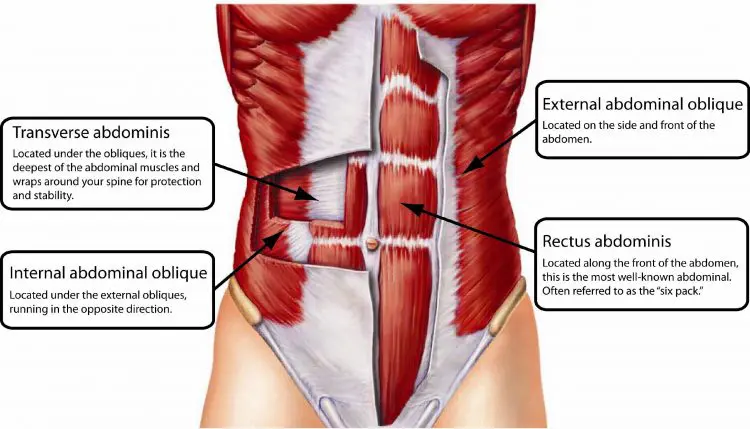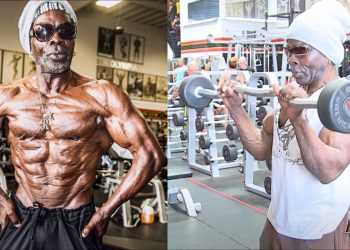One of the biggest barriers to exercise is lack of time. Work and family commitments can make fitness programs hard to stick to, and a lot of people find it impossible to get to the gym more than a couple of times a week.
If you are short on gym time, get more from your workouts by focusing on compound exercises. That way, you won’t need to work out as often or as long.
Another way around your lack of time is to supplement or even replace gym-based workouts with exercises you can do at home. This saves time because you won’t have to travel to the gym and can work out anytime you have a few minutes spare.
Core exercises are especially good for home workouts, as many require nothing except for a gym mat to lie on. No mat? You can just use a folded towel instead. While such an approach won’t do much for your strength or muscle mass, it’ll still be good for your general fitness and health.
In this article, we discuss knee tucks which are a bodyweight core exercise that’s perfect for home workouts.
Knee Tucks Muscles Worked
Knee tucks are a bodyweight core exercise that emphasizes your abs and hip flexors. The main muscles involved in knee tucks are:
Level Up Your Fitness: Join our 💪 strong community in Fitness Volt Newsletter. Get daily inspiration, expert-backed workouts, nutrition tips, the latest in strength sports, and the support you need to reach your goals. Subscribe for free!

Rectus abdominis – known as your abs for short, the rectus abdominis is the flat muscle located on the front of your abdomen. Its primary functions are flexion and lateral flexion of your spine and the compression of the abdominal cavity. If you are lean enough, this is the muscle that gives you a six-pack. The Rectus abdominis works mainly as a stabilizer during knee tucks.
Iliacus and psoas major – collectively called the iliopsoas, these muscles work together to flex your hips. Working with one of the quadriceps, the rectus femoris, these muscles are very active during knee tucks.
Transverse abdominis – encircling your waist like a weightlifting belt, the transverse abdominis, or TVA for short, creates the intra-abdominal pressure that stabilizes your lumbar spine. This muscle is engaged when you “brace” your core.
Obliques – the obliques act as stabilizers during knee tucks to prevent unwanted movement. There are two pairs of oblique muscles; internal and external. Basically your waist muscles, their function is rotation and lateral flexion of the spine.
Quadriceps – the quadriceps are your thigh muscles, and they’re responsible for extending your knees during knee tucks. There are four quad muscles; vastus lateralis, vastus medialis, vastus intermedius, and the already-mentioned rectus femoris. While the quads are involved in knee tucks, they’re not working especially hard.
How to Do Knee Tucks
Get more from knee tucks while keeping your risk of injury to a minimum by following these guidelines:
- Sit on the floor with your legs bent and feet flat. Place your hands on the floor next to your hips for balance. Brace your abs.
- Lift and extend your legs out in front of you, so your feet are a few inches off the floor. Lean back, so you are balancing on your butt/sacrum. Your body should resemble a shallow V-shape.
- Bend your knees and pull your legs in while simultaneously moving your upper body forward.
- Lean back while extending your legs and repeat.
Knee Tuck Benefits and Drawbacks
Not sold on knee tucks? Not sure if they deserve to be part of your core workouts? Consider these benefits:
Do them anywhere and anytime – you don’t need any equipment to do knee tucks. In fact, because you sit down rather than lying on your back, you don’t even need a mat. This makes them ideal for home workouts and anyone who wants to work their abs outside of the gym, e.g., the local park.
No set-up time – you can get into position and start a set of knee tucks in seconds. This makes them ideal for fast-paced workouts like circuit training, HIIT, and supersets.
Works your hip flexors and core together – a lot of core exercises work your abs in isolation. While that’s not necessarily a bad thing, it’s not how they work in nature. Activities like throwing, pushing, kicking, and punching use your hip flexors and core together, and so do knee tucks. This means that knee tucks are arguably more functional than isolation abs exercises like crunches.
While knee tucks are a mostly beneficial exercise, there are also a couple drawbacks to consider:
Back pain – knee tucks involve a lot of hip flexor activity. The hip flexor muscles run from your femurs to your lumbar spine. When activated, these powerful muscles can cause hyperextension of your lower back, resulting in lower back pain. That’s why you MUST brace your TVA during knee tucks. However, if you can’t maintain lumbar spine stability during this exercise, you may feel it in your back. It could even cause injury.
The abs mainly act as a stabilizer – there is very little spinal flexion during knee tucks. That means your abs do not shorten or lengthen much. Instead, they contract isometrically to stop your spine from extending as you straighten your legs. While this is not necessarily a bad thing, if you want to develop your rectus abdominus fully, you also need to perform exercises that involve more movement of your spine, such as cable crunches.
Top 7 Knee Tuck Variations and Alternatives
Knee tucks are a highly effective core and hip flexor exercise, but that doesn’t mean you should do them all the time. There are several variations and alternatives you can use to keep your core workouts productive and interesting:
1. Bench knee tucks
Using a bench for knee tucks increases your range of motion, making them a little more challenging. It also saves you from sitting on the floor.
How to do it:
- Sit on a bench with your hands next to your hips and legs extended in front of you, heels resting on the floor. Brace your abs, lean back, and lift your feet a few inches off the floor.
- Bend your legs and pull your knees in while simultaneously leaning forward.
- Return to the starting position and repeat.
- Less advanced exercisers can rest their heels on the floor between reps.
Level Up Your Fitness: Join our 💪 strong community in Fitness Volt Newsletter. Get daily inspiration, expert-backed workouts, nutrition tips, the latest in strength sports, and the support you need to reach your goals. Subscribe for free!
2. Twisting knee tucks
When you do regular knee tucks, your obliques work mostly as stabilizers preventing unwanted rotation. With this variation, you purposely engage your obliques by adding a twist.
How to do it:
- Sit on the floor with your legs bent and feet flat. Place your hands on the floor next to your hips for balance. Brace your abs.
- Extend your legs out in front of you, so your feet are a few inches off the floor. Lean back, so you are balancing on your butt/sacrum.
- Bend your legs and pull your knees in and across toward one shoulder while simultaneously leaning forward.
- Lean back as you extend your legs and repeat.
3. Double crunch
The double crunch is a lot like knee tucks. However, this variation involves more purposeful spinal flexion, which should result in greater rectus abdominis activation. This exercise is considerably more demanding than knee tucks.
How to do it:
- Lie on your back with your legs straight. Place your hands on your temples. Brace your abs and lift your feet a few inches off the floor. Make sure your lower back is flat.
- Bend your legs and pull your knees in while simultaneously lifting your head and shoulders off the floor. Take your elbows toward your knees.
- Extend your legs, lay back down, and repeat.
- You can also do this exercise with one leg at a time, which is a little easier.
4. V-ups
Also known as V-sits and V sit-ups, the V-up is a challenging bodyweight exercise for your abs and hip flexors. This is a good option if you’ve mastered knee tucks or just want to add more variety to your core workouts.
How to do it:
- Lie on your back with your legs straight and arms on the floor above your head. Brace your abs and press your lower back into the floor.
- Lift your arms and legs at the same time and reach up toward your toes. Balancing on your butt, your body should resemble a V-shape.
- Lie back down and repeat.
- For an easier workout, try lifting just one leg at a time.
5. Hanging knee raises
Hanging knee raises work the same muscles as knee tucks but, for this one, you’ll be lifting the entire weight of your legs, so they’re much more challenging. You can do hanging knee raises from any suitable overhead bar, such as a tree branch, ceiling joist, pull-up bar, or using a bench called a captain’s chair.
How to do it:
- Hang with your legs straight and abs braced. Pull your shoulders down and back and look straight ahead.
- Bend your legs and pull your knees up so they are at least level with your hips and, preferably, chest height. Tip the bottom of your pelvis forward and up to form a shallow C-shape with your spine.
- Slowly lower your legs and repeat.
- As you get stronger, you can progress to doing this exercise with straight legs.
Related: Hanging Knee Raise Alternatives
6. Rollouts
While rollouts don’t look anything like knee tucks, they actually work the same muscles. As with knee tucks, your abs don’t shorten or lengthen much during this exercise, and their main job is stabilizing your spine. As an added benefit, rollouts also work your lats, which is an important upper-body muscle.
There are several ways to do rollouts, including kneeling, standing, with an abs roller, barbell, suspension trainer, or stability ball.
Read also: Learn all about rollouts in our in-depth guide.
7. Hollow holds
Just like knee tucks, hollow holds are an isometric core that also works your hip flexors. That means your abs are working hard, but they do not change in length or produce any movement. This is a very functional exercise, and it’s a lot tougher than it looks!
How to do it:
- Lie on your back with your arms extend overhead, biceps next to your ears.
- Straighten your legs and point your toes. Press your knees and feet together. Brace your core and contract your rectus abdominis.
- Lift your feet, legs, shoulders, and arms off of the floor and press your lower back into the ground. Your body should resemble a shallow dish, i.e., hollow.
- Hold for just a few seconds and then relax, working up to longer holds as you get stronger.
Related: Hollow holds guide
Knee Tucks – Wrapping Up
When time is short, don’t do your core training at the gym. Instead, focus on the exercises you can’t do at home, like squats, bench presses, and deadlifts. Then, when you have a few minutes spare, drag out your gym mat and work your core at home using bodyweight exercises. Just a couple of 10 to 15-minute workouts per week is all you need to develop a stronger, firmer midsection.
There are dozens if not hundreds of bodyweight abs exercises that are perfect for home use, and now you can add knee tucks to the list. Even if you can’t make it to the gym, you can still train; there really is no excuse for skipping workouts!
Interested in measuring your progress? Check out our strength standards for Bench Press, Cable Crunch, Sit Ups, and more.











